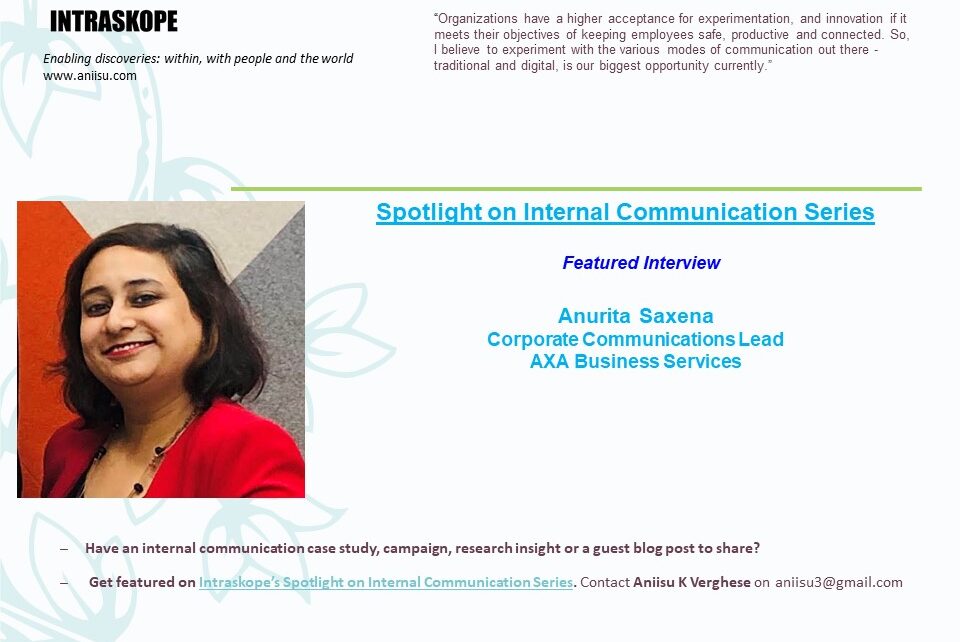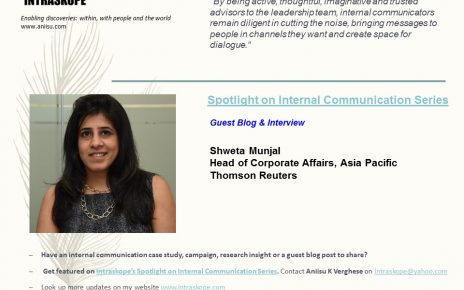Presenting the next edition of Intraskope’s Spotlight on Internal Communication Series featuring Anurita Saxena of AXA Business Services. Watch the complete video interview on YouTube or read the transcript below.
Anurita has over a decade of experience managing internal and external communications. She has worked in the manufacturing, technology, telecom & insurance sectors, and has seen communications evolving from an enabling function to a strategic lever. Personally, she relates to communication as the art of engaging storytelling. Anurita addresses the need for risk evaluation and mitigation while engaging on internal communications. Often, stakeholders focus on speed and forget how to balance pace with patience. She also offers a glimpse into an employee wellbeing campaign at her organization and provides tips for aspiring practitioners to gain from this evolving domain. Learn more here.
Interview
1. What does internal communication mean to you?
It is the thread that binds the organization, extrinsically as well as intrinsically. A very vital lever that can strengthen how an organization’s strategy is brought to life. On the contrary, it isn’t managed well, there are possibilities of it spiraling out of control and paving the way for crises.
2. How is it practiced in your organization?
During these current times, where we are seemingly a notch higher than VUCA, it is the absolute lifeline of an organization. At AXA Business Services, we are tying together leadership and employee communication to streamline two-way flow of thoughts and information, which is much needed during these uncertain times of remote working, With constant and consistent communication from our leaders on wellbeing, policies, business, remote working and returning to work, the employees feel connected. With frequent internal mood checking-in surveys, and actions on the findings, the employees are feeling heard. We are trying to put to rest the inevitable anxiety that is looming. In general, at AXA, internal communications is used as a strategic lever. We are involved when the organization-wide objectives are set and the execution comes into picture.
3. Please share an example/campaign that you are personally proud of working on and that made a significant impact to an organization in the recent past
Employee wellness campaign: When the lockdown came into being, we realized how people were grappling with the diminishing line between home and work, as work entered homes. To make matters tricky, there are children and their virtual classes. And to further increase worries, the domestic help disappeared. It needed learning and revising a lot of old tricks. Not only did we restrict ourselves to advising them on WFH tips and tricks, but we chartered into a more personal territory of telling them the various nuances of physical and mental wellbeing at these difficult times, not only for themselves, but also their spouses, children. And to coach them to draw the line between work and home, and weekends and weekdays. The campaign was received very positively across the organization. The employees felt empathized and supported and would look forward to receiving these tips from their leaders.
4. What is the biggest challenge you face while going about managing internal communication?
The expectation on speed without a proper risk mitigation is what I believe has been a consistent challenge. It is important to deliver fast, and while organizations today have the appetite towards failures, provided they come with good learning, a proper risk mitigation is vital. Some key stakeholders in their excitement to implement some ideas, do not exhibit the patience for risk evaluation and mitigation. That is a challenge I face.
5. What according to you is the biggest opportunity that internal communicators have?
Organizations have a higher acceptance for experimentation, and innovation if it meets their objectives of keeping employees safe, productive and connected. So, I believe to experiment with the various modes of communication out there – traditional and digital, is our biggest opportunity currently. The work-model for any organization has not undergone such a compulsive transformation at this scale, and therefore with the right internal communication support, and while adhering to data and an individual’s privacy, communications can work wonders.
6. How can internal communicators add more value to the business?
By doing their core job – keeping everyone informed and engaged by deploying the right tools. Companies are looking for that, and employees in-turn will only value this.
7. What skills must they have or develop?
Storytelling with a higher eye to detail, and a holistic 3rd party proof-reading skill to ensure that the story does not raise unidentified doubts, anxieties or suspicions. Improved networking to harness the power of connectivity within the communications fraternity More technical know-how to see what different tools can bring to the table. Leverage existing internal communication channels to penetrate deeper in the employee workspace. Global collaboration- very importantly within the organization
8. What is your advice for people who are keen to join internal communication and make a career?
There has not been a more exciting time to join communications – external as well as internal. Technology has continued to change the face of operations worldwide, and communications is no different. The time is now to harness it more than earlier and leverage the experimenting appetite of organizations. Also, I believe the respect this function currently has now gained is unprecedented.
9. What is your advice for women who want to make a mark in this domain and what must they do differently?
No special advice for women, they are already doing very well in this field. Communications, unlike other fields, has been able to break the shackles of patriarchy (if there were) and therefore, we don’t need a special voice here.
10. With COVID-19 and other crises, how must internal communications engage? What has changed or will change? Examples of how your organization has helped reassure employees and navigate the crisis as it unfolds.
Be the strategic lever on which an organization and its employees can count. Deploy all available channels to their best potential. See what works best in your business model, experiment and charter your path. What has changed is the lower tolerance towards complacency in which we do things, and that is true for communications as well. Also align with global counterparts, and not be restricted to and governed by pandemic situations in India only. The world may be healing differently, but every individual is dealing with the similar problem. At AXA Business Services, we have bridged the gap of remote working by deploying various channels to our advantage, and then using the traditional personal connect to further deepen the penetration of the various messages that come in from leaders and our global organization.
11. Can you share one trend that you spot with internal communications?
Openly sharing best practices as well as prevailing vulnerabilities in our respective organizations with other members of the communications fraternity
12. If there is one aspect of internal communications you would like to change, what would that be?
Whatever is getting obsolete is by nature, losing out on the race to evolve. So, I don’t see a need to force a change in this process.
Liked the interview? Post your comments and share it with your network.
Keen to contribute and participate in the ongoing series on Intraskope where we put the spotlight on thought leadership, great ideas, and practical solutions? Look up the previous stories from organizations featured on the Intraskope’s Spotlight on Internal Communication Series here – Subex, global insurer, Standard Chartered Bank, BASF, Applied Materials India, Microsoft UK, Times Group, Samsung, Falabella, Brillio, UAE Exchange, Apeland, M.H. Alshaya Co, Proctor & Gamble, Infosys, SOBHA Ltd., ICICI Securities, First Advantage, CK Birla Group, TVS Motors, GE, Suzlon, Tata Sons, Percept, Knight Frank, TCS Europe, Vedanta, Oxfam, Danske Bank, Diageo, Pandora, Symantec, ISS Global Services, Telia, Thomson Reuters, IBM, General Motors, Intelligence India Software Solutions and Philips.
Intraskope (www.aniisu.com) is the first blog on internal communications in India and among the earliest around the globe. Begun in 2006, the blog has over 1000 posts on topics such as employee engagement, leadership communication and employee branding and receives thousands of visits from across the world. The blog, receives over 1,50,000 visits every month from over 50 countries globally, offers learning resources for practitioners, academicians, and students including industry workshops, research reports, and checklists.
Intraskope has been featured on leading global internal communication forums like Simply-Communicate, IC Kollectif and International Association of Business Communicators. It is hosted by Aniisu K Verghese, author of Internal Communications – Insights, Practices & Models (Sage, 2012).
If you are an internal communication leader working in a firm or a not-for-profit anywhere in the world and have an internal communication case study, campaign, research insight or a guest blog post to share please contact me on aniisu3@gmail.com
Here are Internal Communications resources you can use:
• Internal Communications Series: https://forms.gle/KcqmPzLwq7NQi5Km6
• Chat with Aniisu – Internal Communications: https://www.instamojo.com/intraskope/connect-with-aniisu-60-minute-personalized-d/?ref=store
• Internal Communications workshops: https://bit.ly/2zdBRl1
You can also visit my website www.intraskope.com and You Tube channel to know more about my work.


